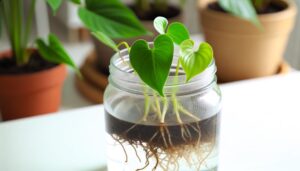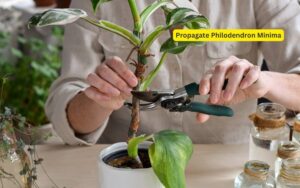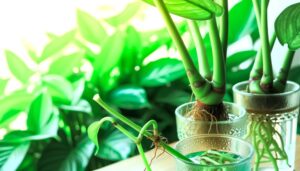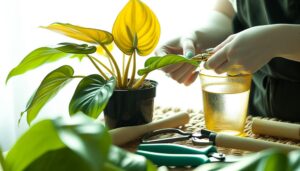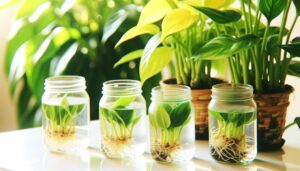African Philodendron Propagation: Step-by-Step Guide!
African Philodendron propagation involves a structured approach to guarantee success. Begin by selecting vigorous, mature stems free from discoloration and common issues.
Use sanitized pruning shears to cut below a node, eliminating lower leaves to prevent rot. Rooting can be done in water, emphasizing proper water quality, hygiene, and indirect sunlight to stimulate growth.
Once roots develop, transfer cuttings to well-draining soil, maintaining consistent moisture and humidity levels. Utilize rooting hormone to enhance root system development and adhere to a structured watering schedule to prevent root shock.
Further steps and details can substantially improve propagation outcomes.
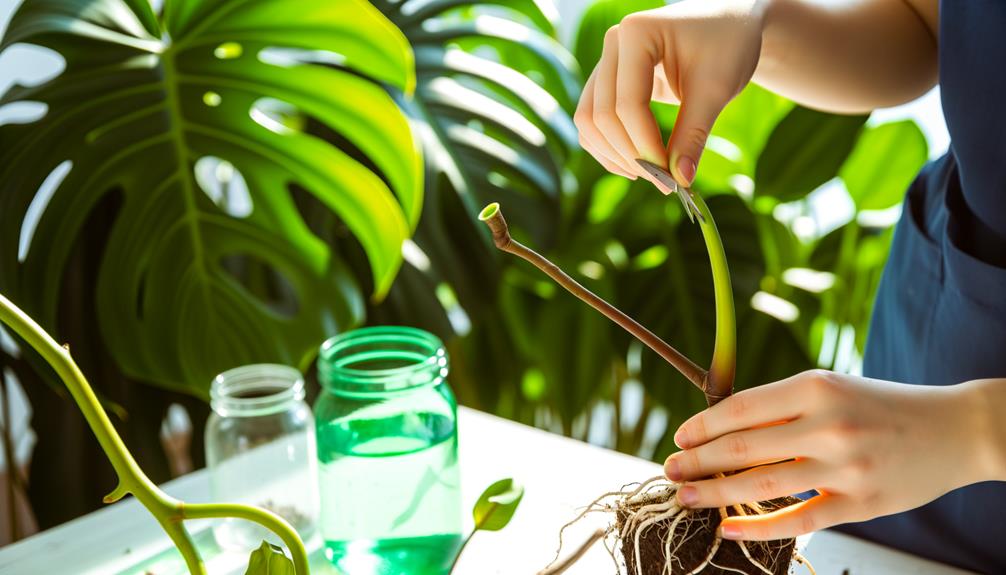
Key Takeaways
- Select healthy, mature stems and cut below a node for optimal root development.
- Use sanitized pruning shears to prevent pathogen spread and increase success rates.
- Immerse cuttings in clean water, ensuring proper hygiene and indirect sunlight exposure.
- Transfer rooted cuttings to well-draining soil, maintaining structured watering to avoid root shock.
- Maintain high humidity and regular misting to support root development and overall plant health.
Choosing the Right Tools
To ensure successful spread of African philodendrons, it is crucial to select appropriate tools. These tools include sanitized pruning shears, rooting hormone, and clean containers with well-draining soil.
Sanitized pruning shears are essential to prevent the introduction of pathogens that could jeopardize the health of the plant. Rooting hormone facilitates the development of a strong root system by promoting root cell differentiation and growth.
Clean containers, ideally with drainage holes, prevent waterlogging and reduce the risk of root rot, thereby ensuring ideal aeration and moisture levels. The soil must be well-draining to maintain a balance between moisture retention and aeration, critical for root health.
Using these tools correctly is essential for achieving high success rates in philodendron propagation.
Selecting a Healthy Stem
When selecting a healthy stem for African Philodendron propagation, it is important to identify signs of vigorous growth, such as firm texture and vibrant coloration.
One must also meticulously avoid stems exhibiting common issues like discoloration, softness, or pest damage.
Ensuring the stem’s best health will greatly enhance the likelihood of successful propagation and robust new growth.
Identifying Ideal Growth Signs
Identifying ideal growth signs in a healthy stem of an African Philodendron is crucial for successful propagation. This task requires a thorough examination of factors such as stem thickness, node presence, and leaf vitality. A robust stem is vital as it indicates strong internal transport systems, necessary for nutrient and water uptake.
Presence of nodes is essential since these are where roots will develop. Leaf vitality, characterized by vibrant, unblemished foliage, reflects overall plant health. When selecting a stem, consider the following indicators:
- Stem Thickness: A thicker stem suggests a well-developed vascular system.
- Node Presence: Nodes are crucial for root formation.
- Leaf Color: Healthy stems exhibit leaves with deep green pigmentation.
- Absence of Pests: Ensure no visible pests or damage.
These indicators collectively signify a stem’s readiness for propagation.
Avoiding Common Stem Issues
Ensuring the selection of a healthy stem for African Philodendron propagation involves meticulously examining potential issues such as pest infestations, signs of disease, and structural weaknesses.
Begin by inspecting the stem for any visible pests, such as aphids or spider mites, which can compromise the plant’s health. Look for discoloration, unusual spots, or wilting, as these could indicate fungal or bacterial infections.
Additionally, evaluate the stem’s structural integrity; it should be firm and free from any cracks or soft, mushy areas. Avoid stems with physical damage or those showing signs of rot.
Prioritizing these examinations will enhance the likelihood of successful propagation, ensuring the new plant grows robustly and remains resilient against environmental stressors.
Ensuring Optimal Stem Health
After thoroughly examining for potential stem issues, the next step is to focus on selecting a stem that exhibits peak health characteristics for African Philodendron propagation.
A careful selection process maximizes the highest chance of successful rooting and growth. Look for stems that exhibit the following attributes:
- Firm Texture: The stem should be sturdy, not soft or mushy, indicating robust internal structure.
- Vibrant Color: Healthy stems typically display a lush green hue, free from discoloration or yellowing.
- Visible Nodes: Choose stems with multiple nodes, as these are the points where roots will emerge.
- Absence of Pests: Ensure the stem is free from visible pests or pest damage which could hinder propagation.
Selecting a healthy stem is critical for best propagation results.
Preparing the Cuttings
Initiating the process of preparing cuttings involves selecting healthy, mature stems from the African Philodendron, making sure they exhibit strength and are free from disease. Begin by identifying stems that are robust and display a rich green color, indicative of vitality.
Using sterilized, sharp pruning shears, make a clean cut below a node—a vital site for root development. Each cutting should ideally be 4-6 inches in length and have at least two to three nodes, as these nodes are crucial for successful propagation.
Remove any lower leaves to prevent rot and ensure the upper leaves remain intact to facilitate photosynthesis. This meticulous preparation primes the cuttings for optimal rooting success, setting a solid foundation for subsequent propagation stages.
Rooting in Water
To facilitate the rooting process in water, immerse the prepared cuttings in a clean receptacle filled with distilled or filtered water, making sure that the nodes are submerged while the leaves remain above the waterline. This method minimizes contamination risks and promotes peak root development.
Regular monitoring and maintenance are essential to ensure successful propagation. Key considerations include:
- Water Quality: Use distilled or filtered water to prevent mineral buildup.
- Container Hygiene: Clean the receptacle periodically to avoid bacterial growth.
- Water Changes: Replace water every 3-5 days to maintain oxygen levels.
- Light Exposure: Provide indirect sunlight to encourage photosynthesis without overheating.
Transferring to Soil
When moving African Philodendron cuttings from water to soil, it is important to guarantee proper soil preparation to facilitate root acclimation. Using a well-draining potting mix, rich in organic matter, helps in shifting the roots effectively.
Following a structured watering schedule is necessary to maintain ideal moisture levels and prevent root shock.
Soil Preparation Tips
Creating the perfect soil conditions is crucial for the successful propagation of African Philodendrons, as it directly impacts root development and overall plant health. A well-prepared soil mix guarantees sufficient drainage, aeration, and nutrient availability.
To achieve this, consider the following components:
- Organic Matter: Integrate compost or well-decomposed manure to enhance soil fertility and structure.
- Aeration: Include perlite or coarse sand to enhance aeration, preventing root rot.
- pH Balance: Maintain a slightly acidic pH (5.5-6.5) by adding peat moss.
- Drainage: Make sure the pot has drainage holes and use a well-draining mix to avoid waterlogging.
These steps establish an ideal environment for root systems to flourish, promoting robust growth and healthy plants.
Root Acclimation Process
After preparing the best soil conditions, the next vital step is to carefully acclimate the roots of the African Philodendron when transferring them from water to soil. This process guarantees that the plant adapts effectively, minimizing transplant shock.
Begin by gently rinsing the roots to eliminate any water residue, then place them into the prepared soil, ensuring even distribution. Gradually introduce the plant to its new environment by initially placing it in a shaded area before shifting to indirect sunlight. Monitoring the plant’s response during this period is essential.
| Step | Details |
|---|---|
| Root Rinsing | Gently eliminate water residue |
| Placement | Position roots evenly in soil |
| Shading | Start in a shaded area |
| Light Shifting | Move to indirect sunlight gradually |
| Monitoring | Observe plant response |
These steps facilitate a successful acclimation.
Watering Schedule Guide
Establishing an ideal watering schedule is critical to guaranteeing the successful adaptation of African Philodendron when moving it from water to soil. This shift phase requires careful attention to the plant’s hydration needs to minimize transplant shock and promote vigorous growth.
A balanced watering regimen is crucial, avoiding both desiccation and waterlogging, which can hinder root development.
Key guidelines for watering include:
- Initial Hydration: Water the soil thoroughly at the time of transfer to maintain consistent moisture.
- Monitor Soil Moisture: Use a moisture meter to sustain optimal levels, avoiding excessive dryness or saturation.
- Frequency Adjustment: Gradually reduce watering frequency as roots establish, encouraging deeper growth.
- Environmental Considerations: Adjust watering schedules based on ambient humidity and temperature variations.
Aftercare and Maintenance
Proper aftercare and maintenance of African Philodendron cuttings are pivotal for fostering robust root development and guaranteeing long-term plant health. Initially, maintain a humid environment to enhance root growth.
Place the cuttings in a location with bright, indirect sunlight, as direct exposure can cause leaf burn. Regularly monitor soil moisture levels to prevent overwatering, which may lead to root rot. Implement a balanced fertilization regimen after roots are established to promote vigorous growth.
| Task | Frequency | Notes |
|---|---|---|
| Humidity Maintenance | Daily | Use a humidifier or mist the leaves |
| Light Exposure | Ongoing | Ensure bright, indirect sunlight |
| Soil Moisture Check | Every 2-3 days | Keep soil consistently moist, not soggy |
| Fertilization | Monthly (post-rooting) | Use a balanced liquid fertilizer diluted to half strength |
Consistent adherence to these practices will guarantee the thriving of African Philodendron cuttings.
Conclusion
The propagation of African philodendrons, from selecting fitting tools to guaranteeing careful aftercare, underscores the significance of each phase in cultivating healthy plants.
By adhering to exact steps—choosing sturdy stems, preparing cuttings, rooting in water, and eventually transferring to soil—one maximizes the chances of successful propagation.
How does one guarantee continuous growth and health post-transplantation? Consistent maintenance, including suitable watering and light conditions, is essential to fostering an ideal environment for these tropical specimens.

